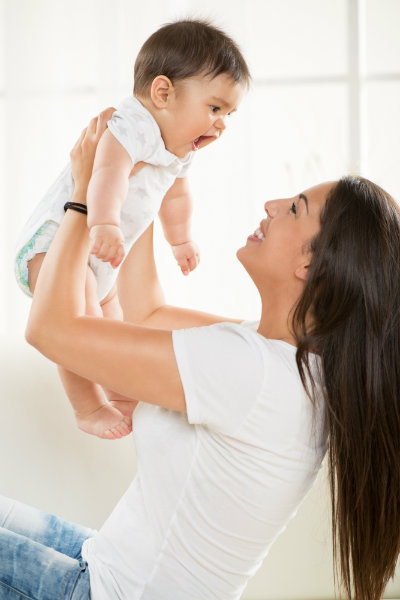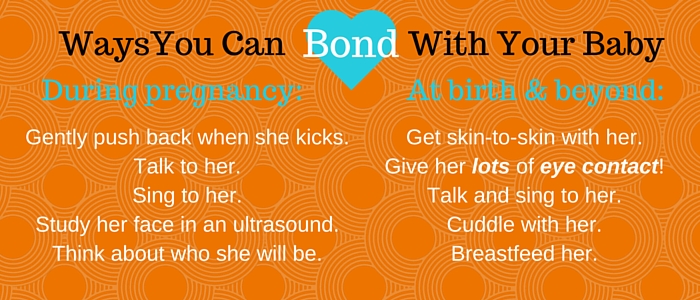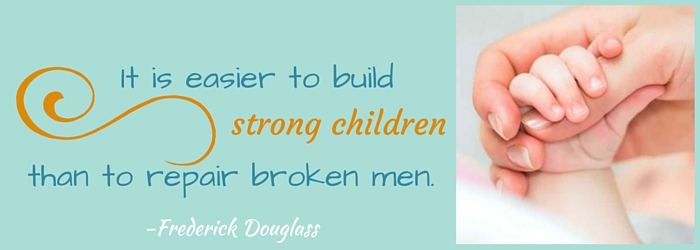What if you could give your baby a golden key to loving and being loved?
While that may sound like the stuff of fairy tales, it’s not as imaginary as you think. You can interact with your baby in a way that helps her grow up more secure, more open, and more loving toward other people. And that’s the stuff of healthy relationships.
So what is this golden key to loving relationships?
It’s called bonding.
What is Bonding?
For an in-depth answer, take a look at our earlier blog here. Basically, bonding is what you do to create an intense attachment between you and your child. It consists of the ways you form an emotional connection with her. Your efforts to bond with her will allow and encourage her to connect with you.
What’s the Difference Between Bonding and Attachment?
While some people use those two words as if they’re the same thing, some make a distinction. Here, we’ll refer to “bonding” as the process of forming a connection between mother and child; we’ll use “attachment” to mean the quality of that bond. Like when you’re gluing two things together: “bonding” is what you’re doing by holding the two pieces tightly while the glue sets up, and when the glue dries you can pull on the pieces to see how strong their “attachment” is.
How Can I Bond With My Baby?
Try some of these ideas:
What Happens if I Don’t Bond With My Baby?
Bruce Perry, MD, PhD, of the Child Trauma Academy, estimates that 1 in 3 people has experienced attachment problems. He believes most parents are ignorant about “the critical nature of the experiences of the first three years of life.” You see, during those first three years your child’s brain is developing an understanding of relationships. If you don’t bond with your baby you are, in effect, programming her to fail at relationships.
That sounds harsh. Because, sadly, it is.
Dr. Perry has observed several harsh realities in children who didn’t experience healthy attachment with their parent(s). These behaviors may show up in varying intensities depending on the nature of a child’s situation.
- Aggression and cruelty. One of the major dangers for your child is that she will learn to be aggressive and cruel. Bonding would teach your child to feel empathy and to control her impulses in order not to hurt others, just as she would not want to be hurt. Without bonding, your child can become a woman who hurts others (purposefully or without knowing it would hurt). She may take advantage of weaker people. And she’ll do it all without remorse.
- Modeling inappropriate behavior. If your child experiences neglect or abuse—the opposite of bonding and attachment—she is likely to treat others the same way. She thinks the treatment she received is “right”—even when it’s absolutely wrong.
- Emotional problems. Your child may develop depression or anxiety, or seek “indiscriminant attachments” (such as hugging strangers) if she hasn’t securely attached to you.
- Developmental delays. Your child needs a secure connection with you to develop well physically, emotionally, and cognitively. So without good bonding and attachment, she will likely struggle in all those areas.
- Immature or bizarre soothing behaviors. Especially when stressed, your neglected child may find unhelpful ways to soothe herself: biting, cutting, or head-banging, for example.
- Odd eating behaviors. If your child experiences a great deal of neglect or abuse, she may develop strange behaviors related to eating, such as hoarding and hiding food, throwing up, having trouble swallowing, and more.
What if I Know I’m Having Trouble Bonding?
We totally get this. Many things can make bonding a challenge.
If you don’t feel a strong connection to your baby developing by the time you go to your first pediatrician visit, talk it over with your doctor. You may be experiencing postpartum depression.
If you and your baby have been separated quite a bit during her first weeks or months, be very intentional about ramping up your efforts to bond during the time you do have together. “From birth through infancy and childhood there are many steps that lead to a strong mother-infant attachment,” says Dr. William Sears, MD. “Bonding is not a now-or-never phenomenon.”
If life is just really hard right now—especially if you’re carrying around problems from your past—don’t feel like you have to figure this out all alone. We stand ready to help you talk through the challenges you face, and to help you develop a solution. In addition, we have a host of helpful video lessons we can offer you through our Earn While You Learn program. At Choices Pregnancy Center, we want to see you and your child walk into life together with success and joy.
———-
Please come in and talk with us about bonding.
Text today to set up an appointment.
———-
For more information on bonding, check out these articles:
Dr. William Sears’s article at the Attachment Parenting International website
Dr. Bruce Perry’s article on bonding and attachment
Our blog post, “What is Bonding?”



